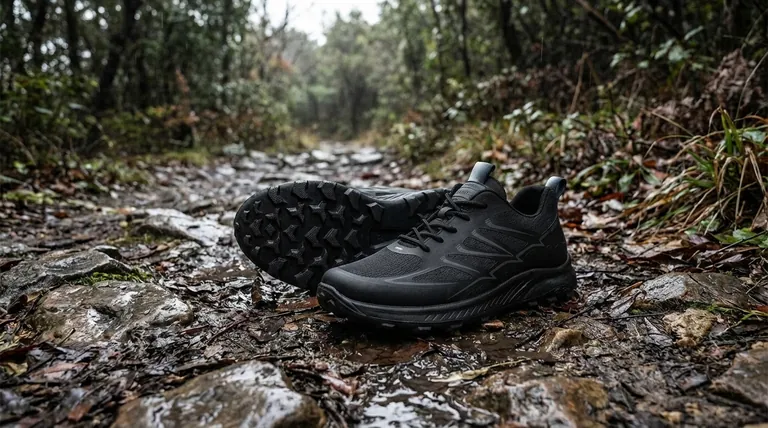While incredibly popular for good reason, rubber shoe soles are not a universal solution. Their primary drawbacks are a lack of breathability which can lead to heat and moisture buildup, a heavier weight compared to synthetic alternatives, and a typically casual or chunky aesthetic that makes them unsuitable for formal footwear.
The "disadvantages" of a rubber sole are simply the inherent trade-offs for its core strengths: unparalleled durability, water resistance, and grip. The key is not to view these as flaws, but as characteristics that make it the ideal choice for some situations and the wrong choice for others.

The Primary Limitations of Rubber Soles
To make an informed choice, it's essential to understand the specific properties of rubber and their practical implications for comfort and style.
Lack of Breathability
Rubber is a non-porous material, meaning it creates an effective seal against the elements. While excellent for keeping water out, this also means it traps moisture and heat inside the shoe, preventing your feet from breathing and potentially leading to discomfort.
Heavier Weight
Compared to materials like leather or modern synthetics like EVA foam, rubber is a dense and relatively heavy material. This added weight can contribute to foot fatigue over a long day of walking, a factor often mitigated in athletic shoes by using lighter compounds.
A Casual Aesthetic
The manufacturing process and inherent properties of rubber lend themselves to thicker, more robust sole designs. This "chunky" appearance provides excellent stability and durability but clashes with the sleek, refined silhouette required for formal dress shoes.
Limited Foot Conformity
Unlike a high-quality leather sole that gradually molds to the unique shape of your foot over time, a rubber sole maintains its original shape. It offers resilience and support but lacks that customized, "broken-in" feel that many value in premium footwear.
Understanding the Trade-offs: When Rubber Excels
The limitations of rubber are a direct result of its greatest strengths. For many applications, these are not drawbacks but essential features.
Unmatched Durability and Protection
The same density that adds weight makes rubber incredibly resistant to abrasion and wear. It can withstand rough surfaces like pavement, gravel, and job sites far better than softer or more delicate materials like leather.
Superior Grip and Safety
Rubber’s ability to conform to micro-surfaces and channel away liquid gives it exceptional traction. This is why it is the undisputed standard for work boots, hiking shoes, and any footwear where slip resistance is a primary safety concern.
Low Maintenance Requirements
Rubber is highly resistant to water, oil, and salt, requiring little more than a simple wipe-down to clean. This stands in stark contrast to leather soles, which are vulnerable to water damage and require regular conditioning to prevent cracking.
How Rubber Compares to Other Sole Materials
Choosing the right sole means matching the material's properties to your intended use.
Rubber vs. Leather
This is the classic trade-off. Leather offers superior breathability, a classic aesthetic, and the ability to mold to your foot, making it ideal for formal dress shoes. Rubber provides far better grip, water resistance, and durability, making it the practical choice for daily and outdoor wear.
Rubber vs. EVA & Synthetics
Modern synthetics like EVA (ethylene vinyl acetate) are extremely lightweight and offer excellent cushioning, which is why they dominate the running and athletic shoe market. However, they typically offer less durability and abrasion resistance than a dense, solid rubber sole.
Making the Right Choice for Your Goal
Select your shoe's sole based on its primary purpose, not on the perceived superiority of one material over another.
- If your primary focus is formal elegance and a custom fit: A leather sole is the superior choice, as its breathability and classic look are paramount.
- If your primary focus is safety, durability, and all-weather grip: A rubber sole is the non-negotiable standard for work, hiking, or dependable daily wear.
- If your primary focus is lightweight cushioning for athletic activity: Look for footwear built with modern synthetics like EVA designed specifically for that purpose.
Ultimately, understanding a sole's material is the key to choosing footwear that performs exactly as you need it to.
Summary Table:
| Drawback | Key Characteristic | Ideal Alternative For |
|---|---|---|
| Lack of Breathability | Traps heat and moisture | Formal, breathable shoes (e.g., leather soles) |
| Heavier Weight | Dense material | Lightweight athletic shoes (e.g., EVA soles) |
| Casual Aesthetic | Chunky, robust look | Sleek, formal dress shoes |
| Limited Foot Conformity | Maintains original shape | Custom-molded, premium footwear |
Need the perfect sole for your footwear line?
As a large-scale manufacturer, 3515 produces a comprehensive range of footwear for distributors, brand owners, and bulk clients. Our production capabilities encompass all types of shoes and boots, from durable rubber-soled work boots to elegant leather-soled dress shoes. We can help you select the ideal sole material to match your target market's needs for comfort, style, and performance.
Contact our expert team today to discuss your production requirements and get a custom quote!
Visual Guide

Related Products
- Custom OEM Training Shoes Wholesale Manufacturer Durable & Breathable
- Safety Footwear Wholesale Manufacturer for Custom OEM/ODM Production
- Durable Waterproof Rain Boots | Custom Manufacturer for Wholesale & Brands
- Wholesale Leather Ankle Boots with Lug Soles for Custom Brand Manufacturing
- Durable Moc-Toe Wedge Work Boots | Wholesale Manufacturing for Brands
People Also Ask
- What industries benefit from safety trainers? Lightweight Protection for Modern Workplaces
- Which type of footwear is better suited for prolonged use in tough environments? Choose Durable Boots for Maximum Safety & Comfort
- What are the main types of reinforced toe protection for tactical boots? Choose the Right Toe for Your Mission
- What is the purpose of cushioning in running shoes? Absorb Impact, Boost Performance
- What are the characteristics of strap-closure work shoes? Speed, Convenience, and Key Trade-offs



















